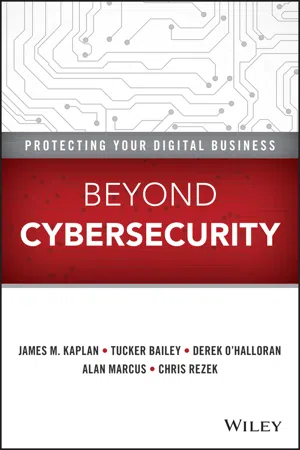
Beyond Cybersecurity
Protecting Your Digital Business
- English
- ePUB (mobile friendly)
- Available on iOS & Android
Beyond Cybersecurity
Protecting Your Digital Business
About this book
Move beyond cybersecurity to take protection of your digital business to the next level
Beyond Cybersecurity: Protecting Your Digital Business arms your company against devastating online security breaches by providing you with the information and guidance you need to avoid catastrophic data compromise. Based upon highly-regarded risk assessment analysis, this critical text is founded upon proprietary research, client experience, and interviews with over 200 executives, regulators, and security experts, offering you a well-rounded, thoroughly researched resource that presents its findings in an organized, approachable style.
Members of the global economy have spent years and tens of billions of dollars fighting cyber threats—but attacks remain an immense concern in the world of online business. The threat of data compromise that can lead to the leak of important financial and personal details can make consumers suspicious of the digital economy, and cause a nosedive in their trust and confidence in online business models.
- Understand the critical issue of cyber-attacks, and how they are both a social and a business issue that could slow the pace of innovation while wreaking financial havoc
- Consider how step-change capability improvements can create more resilient organizations
- Discuss how increased collaboration within the cybersecurity industry could improve alignment on a broad range of policy issues
- Explore how the active engagement of top-level business and public leaders can achieve progress toward cyber-resiliency
Beyond Cybersecurity: Protecting Your Digital Business is an essential resource for business leaders who want to protect their organizations against cyber-attacks.
Frequently asked questions
- Essential is ideal for learners and professionals who enjoy exploring a wide range of subjects. Access the Essential Library with 800,000+ trusted titles and best-sellers across business, personal growth, and the humanities. Includes unlimited reading time and Standard Read Aloud voice.
- Complete: Perfect for advanced learners and researchers needing full, unrestricted access. Unlock 1.4M+ books across hundreds of subjects, including academic and specialized titles. The Complete Plan also includes advanced features like Premium Read Aloud and Research Assistant.
Please note we cannot support devices running on iOS 13 and Android 7 or earlier. Learn more about using the app.
Information
1
Cyber-attacks Jeopardize Companies’ Pace of Innovation
RISK OF CYBER-ATTACKS REDUCES THE VALUE OF TECHNOLOGY FOR BUSINESS
Lower Frontline Productivity
Less Money for IT Initiatives that Create Value

Table of contents
- Cover
- Title page
- Copyright
- Foreword
- Preface
- Executive Summary
- 1 Cyber-attacks Jeopardize Companies’ Pace of Innovation
- 2 It Could Get Better— or $3 Trillion Worse
- 3 Prioritize Risks and Target Protections
- 4 Do Business in a Digitally Resilient Way
- 5 Modernize IT to Secure IT
- 6 Engage Attackers with Active Defense
- 7 After the Breach: Improve Incident Response across Business Functions
- 8 Build a Program that Drives toward Digital Resilience
- 9 Creating a Resilient Digital Ecosystem
- Conclusion
- Acknowledgments
- About the Authors
- Index
- EULA